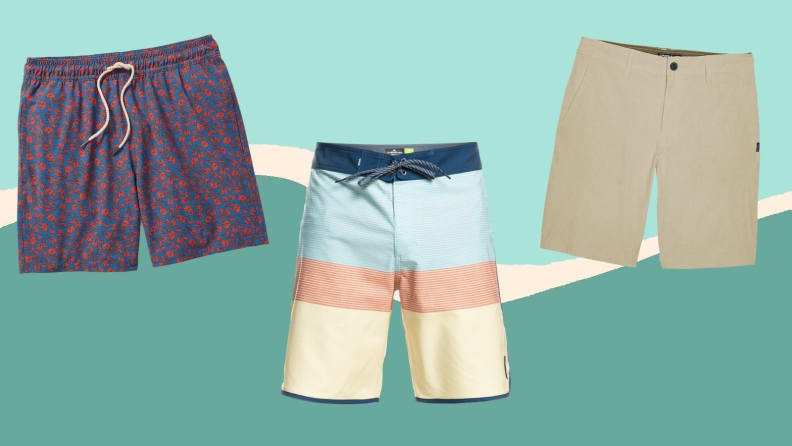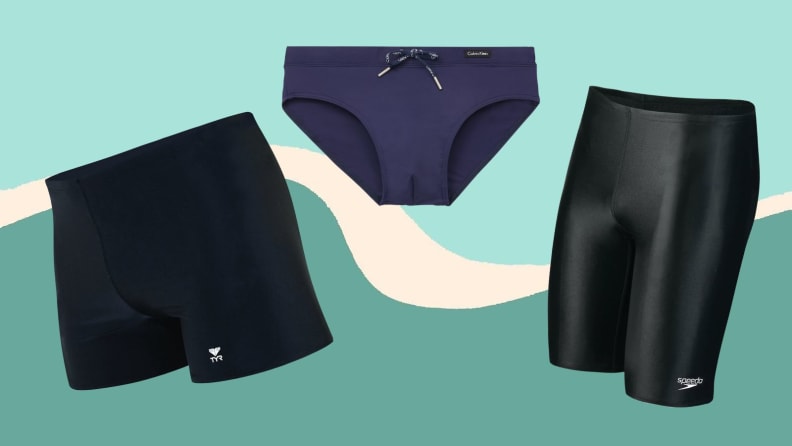How to pick the right men's swimsuit style
Don't get lost in the sea of options, find your favorite suit here.
Products are chosen independently by our editors. Purchases made through our links may earn us a commission.
Whether you're surfing or staying cool by the pool, it all starts with finding the perfect swimsuit. And if you’re hitting “add to cart” before you hit the beach, you’ll find a plethora of swimsuit options available in men’s sizes, ranging from board shorts to skimpy swim briefs.
But with so many styles and fits to choose from, it can be hard to dive straight into swimwear shopping. To pool together all of the options, we consulted San Diego-based personal stylist Vanessa Valiente to break down the most popular types of swimsuits.
What are the types of men’s swimwear?

Pick from swim trunks, briefs, and hybrid shorts (left to right).
When you think swimwear in men’s sizes, you typically consider shorts or trunks that cover the bottom half of the body. Before soaking up the sun or diving into the pool, you’ll want to pick a swimsuit bottom you love. The main attributes to keep in mind include coverage, type of closure, and versatility.
Swim trunks: While “trunks” is often used as a catchall term for men’s bathing suits, the style is “defined by [its] elastic waist,” Valiente says. The short-like suit has a loose fit and sometimes includes mesh pockets so they won’t balloon with water when you take a dip in the pool or ocean. Inseam lengths can vary from about 4 inches up to 8 inches, which is largely a matter of personal preference—though, of course, longer will provide more sun protection.
Trunks are typically lined with mesh or fitted fabric in either the form of underwear-like briefs or shorts that match the length of the suit itself. Choose mesh to keep things breezier and cooler when you’re on land, or compression fabrics to prevent chafing while doing water sports and/or showing more leg than you intend should the outer fabric float up in the water.
Board shorts: Board shorts look similar to trunks, but they have a zipper or an adjustable string closure instead of an elastic. Additionally, while board shorts and trunks often sit in the same spot on the hips, board short waistbands traditionally come up higher, according to Valiente, and are less likely to have a liner. Inseam lengths tend to be a little longer in board shorts than trunks, often between 8 and 9 inches, to protect skin from sun exposure and friction rashes from a surfboard.
Hybrid shorts: Hybrid shorts have a similar silhouette to swim trucks, but look more like real shorts suitable for wearing outside the water. The versatile style is designed to go from “water to play,” as Valiente says. “You can get out of the water then go to a restaurant.” While trunks are available in a range of bright colors and patterns, hybrid shorts sometimes mimic the look of khaki and other material you wouldn't usually associate with swimming.

Tighter fitting styles include square cut shorts, swim briefs, or jammers.
Square-cut or square-leg shorts: Although stores aren't short on short-like swimwear options, there are also a couple of styles that fit more similarly to underwear. Square-cut shorts are akin to boxer briefs, as they cover from the waist to the upper thigh. (Think James Bond in Casino Royale.)
Swim briefs: As the most skin-baring of the swimsuit styles, swim briefs are favored by competitive swimmers, because having both less material and a compressive style prevents drag that could slow competition times. The underwear-like bottoms are often referred to as Speedos, although Speedo is a specific brand of swim brief. “The swim brief is the skimpiest, truly the skimpiest,” Valiente says.
Jammers: Also a favorite of serious swimmers, jammers look similar to bike shorts. They provide both compression and knee-length coverage.
What is an inseam?
Inseam refers to the length from the crotch to where the swimsuit ends on the inner thigh. When selecting an inseam, the right fit comes down to the wearer’s height and personal preference. Inseams of 4 to 5 inches are typically on the shorter side, whereas inseams of 8 to 9 inches will provide extra leg coverage for water activities and so on. Right in the middle, inseams of 6 to 8 inches often fit more like a standard pair of shorts. Valiente recommends opting for something “less than 8 or 9 inches” overall so the swimsuit isn’t, well, swimming on you, noting that nine inches is better suited for those on the taller side.
What are the best shirts to wear at the beach?
If you’re tempted to slip on a T-shirt on top, proceed with caution—and plenty of sunscreen. The Skin Cancer Foundation recommends clothing with an ultraviolet protection factor (UPF) of at least 30 for “very good” protection from the sun’s harmful UV rays or UPF 50+ for “excellent” protection. However, the standard white T-shirt only has a UPF of about 7, which goes down to just 3 when it’s wet. Because thicker, darker colored garments—which naturally have a higher UPF—aren’t ideal for a beach day, consider shopping for UPF-rated clothing, which is designed to be lightweight while also providing protection.
For a top suited to swimming, try a long-sleeve or short-sleeve rash guard. The shirt-like styles were initially designed for surfers, as paddling on the board can cause chafing and rashes (hence the name). Whether you surf or not, you should still get—ahem—on board with rash guards, as many come with UPF ratings, so you’ll know how much sun protection they provide.
What men’s swimwear is best?
It depends on what suits your needs and makes you feel most comfortable. For lap swimming or competition, swim briefs or jammers will keep you gliding through the water. For surfing or stand-up paddle boarding, board shorts keep your skin covered while allowing you to move freely. And for lounging at the beach or poolside, you can wear whatever you like the look of best.
Prices were accurate at the time this article was published but may change over time.
